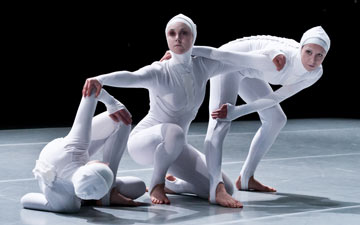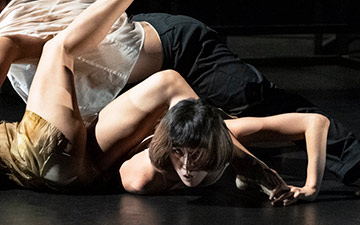
© Benedict Johnson. (Click image for larger version)
H2DANCE
Staging Ages
London, The Place
16 October 2015
www.h2dance.com
www.theplace.org.uk
H2dance is run by Hanna Gilgren and Heidi Rustgaard, choreographers and performers, whose Duet won The Place Prize audience vote in 2013. This year’s production, Staging Ages, involves five performers of different ages and backgrounds, drawing on their own experiences and those of community groups in Britain, Norway and Sweden.
Packed overfull with ideas, it’s a way of looking at how our behaviour changes over the years, while we continue to feel much the same inside. How we play roles, finding ourselves turning into our parents without really growing up; how we find it hard to imagine becoming old and impaired. Is there a body language typical of the seven ages of man or are we unique?
On Friday night, the five performers ranged in age from Sean Dodgson, 10, to Emilyn Claid, 65, with Ella Sophoclides, 16, as the teenager, and Darren Anderson and Laura Doehler as 30-something year olds. They started out in casual gear, treating the array of clothes laid out on the white floor as items from a dressing-up box.
Each established their own signature moves. Sean was swung between Darren’s legs, Ella rejected Laura’s concerns over her clothing, Emilyn intervened to break up quarrelling generations. Then they exchanged routines, so that Sean smacked Darren’s bottom and was smacked in return by Laura. Shouted names and numbers determined who did what to whom, in no chronological order.
‘Eight’ involved dressing-up and cross-dressing; ‘thirty three’ turned Laura into a frazzled multi-tasking mother; ‘ten’ brought out Darren as a controlling father with naughty young Sean; ‘sixteen’ had Emilyn stuffing her face with food. The actions were stylised, choreographed to music by Sylvia Hallett, a soundscore overlaid with spoken words including yet more numbers. Thus, while some of the performers were reverting to childhood, ‘forty’ kept being repeated confusingly (apparently someone’s answer to the question ‘What was your favourite age?’)
In the middle, at ‘twenty two’, came a scene in which the adults removed all their clothes, while the youngsters wore blindfolds and listened to music on headphones. For Scandinavians Gilgren and Rustgaard, nudity is natural and normal – and hardly uncommon in contemporary dance. The scene is far from shocking, or indeed revealing: since the three performers have toned bodies, the physical toll of ageing beyond 22 isn’t evident. British promoters, however, are nervous about presenting shows that have (clothed) children on stage with naked adults. Should the scene be censored in this country so that Staging Ages can go on tour? H2dance will have to decide how much it matters.
Once the clothes were back on, the focus of the hour-long piece shifted to the future. Ella danced an elegant, aspiring solo as she imagined being 19 and no longer a student. Sean mimed drinking and smoking once he was grown up. Then, as Darren whispered instructions in his ear, the 10-year-old-going-on 40 recited business clichés into a microphone: a horrible prospect. Distorted voices in Hallett’s soundscore indicate that things will fall apart as old age advances unstoppably.
Claid, a pioneer of British New Dance in the 1970s and still going strong, remained in denial, dancing an angular, agile, twisting solo until she was obliged to submit to decrepitude at 103 (rather unconvincingly). Instead of an ending with her being carried off in a chair, the cast reprised their signature moves, enjoying being their present ages. Finally, only Sean was left on stage. Born this century, he could well live to see in the next.
Staging Ages is charming, funny and touching without being searching. The vignettes have none of the harshness or cruelty of the Pina Bausch company’s acting-out of childhood memories – for which some audience members may be grateful. There didn’t seem to be a body language associated with different ages (apart from young Sean) since the performers are dance-trained, accustomed to moving easily. They only pretend to be children or old people. A really aged performer, restricted by infirmity, would bring verisimilitude, as the modern dancer Jane Dudley did in her 80s, in multi-generational pieces. Emilyn Claid may be technically a pensioner but she’s not yet ready to be old.

















You must be logged in to post a comment.